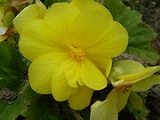
Begonia pearcei
Encyclopedia
Begonia pearcei is a plant
in the begonia family, Begoniaceae
. It was introduced to Europe in 1864 by Richard Pearce
(after whom it was named) who discovered it in the Bolivia
n Andes
and is important in the hybridising of the Begonia × tuberhybrida
begonias, the first of which appeared in 1867.
The description in Hortus Veitchii reads:
Plant
Plants are living organisms belonging to the kingdom Plantae. Precise definitions of the kingdom vary, but as the term is used here, plants include familiar organisms such as trees, flowers, herbs, bushes, grasses, vines, ferns, mosses, and green algae. The group is also called green plants or...
in the begonia family, Begoniaceae
Begoniaceae
Begoniaceae is a family of flowering plants with about 1400 species occurring in the subtropics and tropics of both the New World and Old World. All but one of the species are in the genus Begonia. The only other genus in the family, Hillebrandia, is endemic to the Hawaiian Islands and has a single...
. It was introduced to Europe in 1864 by Richard Pearce
Richard Pearce (botanist)
Richard Pearce was a Victorian plant collector, who introduced the tuberous begonia to England, which led to the development of the hybrid begonias grown today.-Early career:Pearce was born at Stoke, Devonport in Devon...
(after whom it was named) who discovered it in the Bolivia
Bolivia
Bolivia officially known as Plurinational State of Bolivia , is a landlocked country in central South America. It is the poorest country in South America...
n Andes
Andes
The Andes is the world's longest continental mountain range. It is a continual range of highlands along the western coast of South America. This range is about long, about to wide , and of an average height of about .Along its length, the Andes is split into several ranges, which are separated...
and is important in the hybridising of the Begonia × tuberhybrida
Begonia × tuberhybrida
Tuberous begonias are a group of Begonia cultivars, regarded as some of the most spectacular of the genus....
begonias, the first of which appeared in 1867.
Description
This begonia is still grown today, and has dark green leaves with a velvety texture and very marked veins. The small, bright yellow flowers add interest, as it is the only yellow among the tuberous species. Its introduction into the breeding programmes led to today's yellow-flowered forms.The description in Hortus Veitchii reads:
The plant is of tufted habit, has the unusual quality of possessing ornamental foliage and showy flowers. The leaves are dark velvety green above, traversed by straw-coloured veins: the under surface dark red with the exception of a prominent venation. Well above the handsome leaves are borne the bright yellow flowers, usually three in number, on slender scapes.

